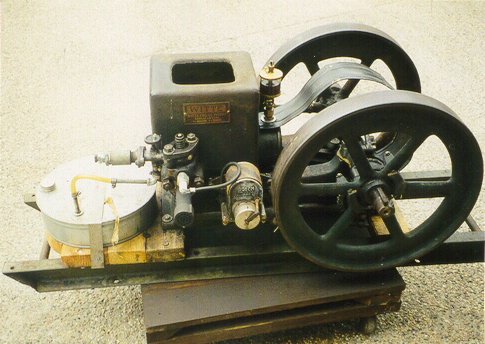|
For the 2000 show, at Orange, the club displayed the Ray Chapdelaine collection of "headless" Witte engines. The collection was shown here many times before Ray passed away and it is still in the possession of his family.
A little bit about the history of the Witte Company:
August Witte, organized Witte Iron Works at Kansas City in 1870. His son, Ed Witte served his apprenticeship in the foundry as a brass moulder, iron moulder, machinist, metallurgist, and finally as a steam engine designer. By the time August Witte retired in 1886, Ed Witte had already built a crude but workable gas engine using hot tube ignition. Company records indicate however, that actual production of the Witte standard and Star engines did not begin until August, 1894.
Witte standard and Star engine styles were built until November, 1914. A 1900 catalog indicates that these impressive sideshaft engines were available in 4, 6, 8, 10, 12, 15, 20, 25, 30, and 40 horsepower sizes for stationary use. Portables could be supplied in any size up to and including 25 horsepower.
1911 Witte embarked on an entirely new engine line. The model of simplicity, these engines were the first Witte models to carry the walking beam valve mechanism that characterized the entire Witte line until November, 1923.
Witte's Junior engine series (now affectionately known as the "headless Witte") included the cylinder and base in a single casting. Likewise the cylinder head was integral, eliminating problems from leaky gaskets and lowering production costs. Both valves were located in a single casting that was easily removed from the cylinder for occasional repairs. Witte portables for 1916 were also available in 6, 8, 12, 16, and 22 horsepower sizes.
Witte's 1916 catalog attempted to allay the fears of prospective customers by noting that anyone could be his own mechanic, just by reading the Witte instruction manual. To illustrate the point, a catalog illustration depicts the method of checking ignition timing. By using any available straight edge, it was quite simple to line up the fly-wheel mark with the top of the water hopper. Precisely at this time, ignition was to occur, and by removing the spark plug and laying it on top of the engine, anyone could easily determine whether the ignition timing was properly adjusted. Similar explanations were included for valve and carburetor adjustments. As a mailorder merchant, Ed Witte had few equals. His catalogs rank among some of the most colorful and explicit in the entire engine industry. Sumptuous three-color illustrations of the engines certainly were a boost to sales, and the technical data was written in the language of the farmer.
This information is from: "American Gasoline Engines Since 1872", by C. H. Wendel, pp 557-560.
|
